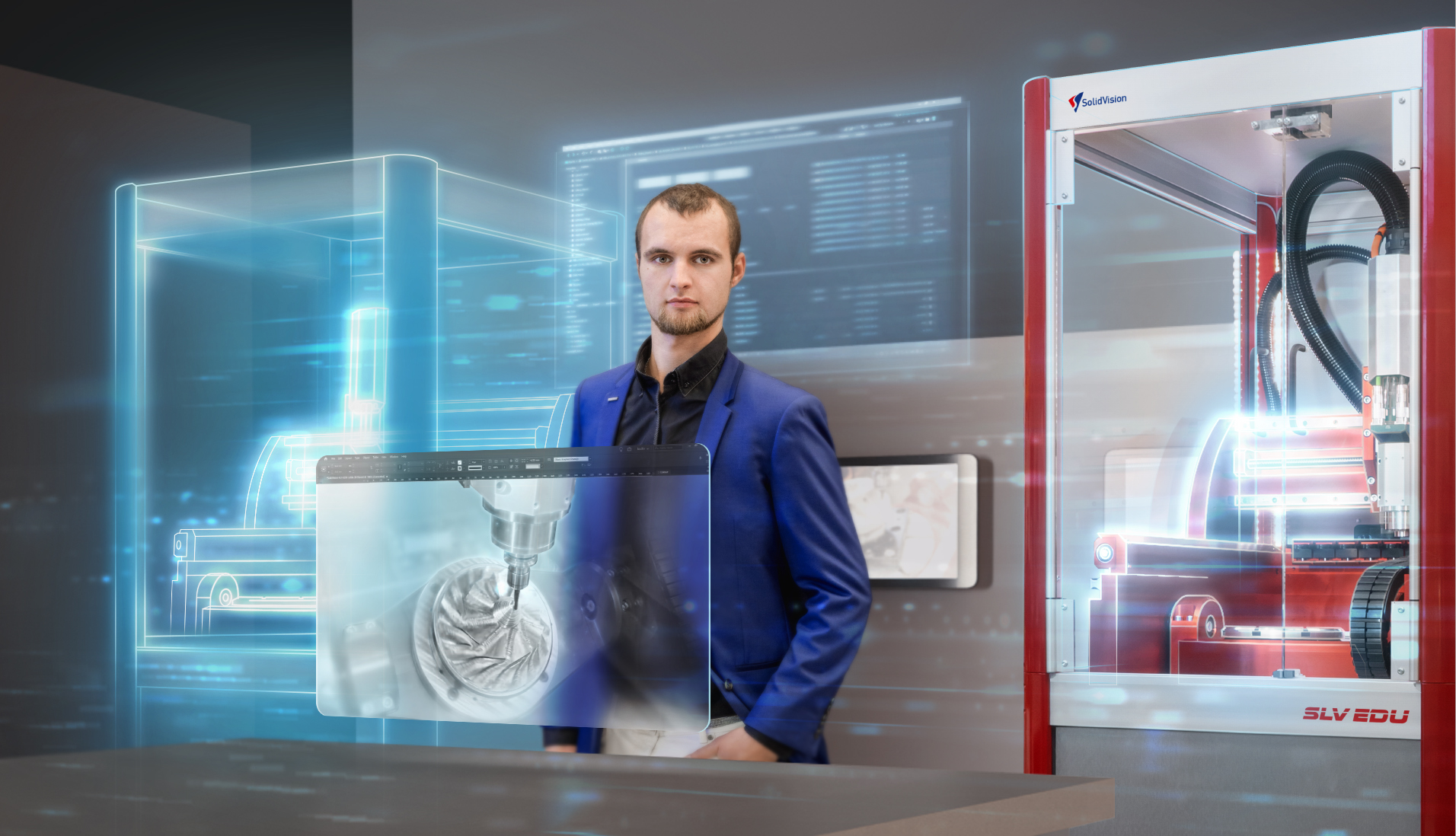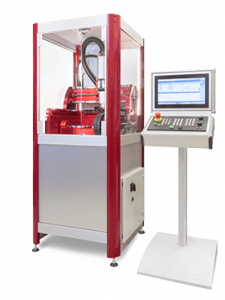
Již je to nějaký ten čas, co společnost Siemens navázala spolupráci se společností SolidVision a napomohla tak vzniku obráběcího stroje určeného pro výuku na školách. Stroj SLV EDU CNC 5axis Siemens tak mohl zazářit na celosvětové soutěži MC Awards a získat tam první cenu.
Tomáš Kopeček: Se strojem SLV EDU jsme se poprvé setkali na akci na Západočeské univerzitě v Plzni, kde společnost SolidVision tento stroj vystavovala. Podoba mechanického stavu stroje se nám velice líbila, ale měl relativně jednoduché řízení. Když jsme ten stroj viděli, řekli jsme si, že je to skutečně dobrý nápad pro vzdělávací účely, ale z našeho hlediska tomu schází duše toho stroje, kterou musíme doplnit. Z našich možností je tou správnou a nejlepší volbou Sinumerik. Sinumerik je otevřený systém, který dokáže vyřešit nejsložitější úkoly, které jsou na obráběcí stroj kladeny. Napadlo nás doplnit výrobek SolidVision o řízení Sinumerik. Kontaktovali jsme proto kolegy ze společnosti SolidVision a postupně jsme začali rozvíjet myšlenku, co by znamenalo, kdybychom stroj vybavili Sinumerikem a pohony Siemens. Představovalo to nemálo práce, jelikož leckde jsme naráželi na malé prostory pro umístění komponent, ovšem vše jsme nakonec zdárně vyřešili s konstruktéry ze SolidCon. Když to vezmu na časové ose, naše první setkání bylo v únoru v roce 2019 a už v září 2019 jsme vystavovali na veletrhu v Brně stroj vybavený Sinumerik ONE. Tehdy to byla naprostá novinka na trhu řídicích systémů obráběcích strojů. Myslím si, že to byla dobrá práce jak ze strany společnosti Siemens, tak ze strany společnosti SolidVision.
Tomáš Kopeček: Aktuální řídicí systém, který naši zákazníci nejvíce využívají, je řada 840D solution line. Je však třeba si uvědomit, že tato řada vznikla někdy v letech 2005 až 2006, kdy jej zároveň začali zákazníci využívat. Z toho plyne, že se jedná o systém téměř 17 let starý. Je logické, že tak, jak se vyvíjí technika, tak se vyvíjí i řídicí systémy, a tudíž Siemens musel přijít s nějakou novinkou. Ta navázala na zkušenosti starší verze 840D solution line, je lepší z hlediska rychlosti a umožňuje další vývoj nových funkcí k řízení obráběcích strojů. Tou novinkou byl systém Sinumerik ONE, který byl poprvé uveden v roce 2019 a vystavovali jsme jej na MSV v Brně na stroji SLV EDU 5axis Siemens. Oproti dřívějším systémům byl Sinumerik ONE nejprve vyvíjen v digitální podobě. Nebylo to tak jako dřív, že by se postavil nějaký fyzický prototyp a ten se zkoušel, doplňoval se softwarově, ale tentokrát vývoj probíhal vyloženě v digitálním světě. A teprve v době, kdy digitální svět ukázal, že podoba Sinumeriku je to, co od toho bylo očekáváno, tak teprve tehdy se začala stavět fyzická podoba systému. Systém Sinumerik ONE se dodává v několika provedeních, od nejjednoduší verze 1740 přes střední verzi 1750 až po nejvýkonnější verzi pro vysokorychlostní obrábění 1760. Na stroji SLV EDU standardně používáme Sinumerik ONE s verzí PPU 1740, čili kompaktní provedení, ve kterém je Sinumerik ONE umístěn přímo v ovládacím panelu.
Adam Koncer: Digitální dvojče vám může pomoci hned ve dvou rovinách. Pokud jste výrobce strojů či vysoká škola, můžete nástroj digitální dvojče využít od mechanické konstrukce po tu elektrickou, až po programování a uvádění do provozu. Myšlenka je taková, že si celý stroj začnete předem chystat virtuálně na počítači, kdy se zároveň ve stejné době stroj vyrobí, dodá, osadí a vše, co se v klidu a bezpečí vyzkouší na počítači, se následně do stroje může nahrát.
Druhá rovina je vhodným využitím pro střední školy, respektive pro obsluhu, kdy si může žák dopředu vyzkoušet, jak se stroj ovládá, aniž by hrozilo jeho poničení. Vybavit učebnu virtuálními stroji je navíc mnohem levnější a jednodušší než fyzickými stroji. Stačí vám jen počítač pro instalaci softwaru, kde vám poběží vizualizace konkrétního stroje a vše si můžete odzkoušet.
Tomáš Kopeček: Škola si tak může například zakoupit 16 licencí digitálního dvojčete, umožňující přípravu technologie na počítači. Studenti si zde mohou vše připravit a zároveň vidí obraz pohybu stroje. Následně se vybere jedno řešení, které se umístí fyzicky na stroj, a studenti mají možnost i ve skutečnosti vidět to, co bylo zvolenou technologií obrábění na stroji požadováno.

Tomáš Kopeček: Samozřejmě, v našem technickém oddělení pracuje v současné době technolog, který má za úkol se starat jednak o koncové zákazníky, ale i o školy. Pokud má tedy škola potřebu pomoci se zavedením digitálního dvojčete, tak jsme připraveni školu navštívit, ukázat jim, jakým způsobem s tím pracovat, a být v blízkém kontaktu. Navíc poskytujeme a využíváme výukové materiály z našeho technologického a aplikačního centra v Erlangenu, kde pro oblast programování a uvádění stroje do provozu vznikají materiály, které se postupně překládají do českého jazyka a mohou být tedy prostředkem výuky na středních i vysokých školách.
Adam Koncer: Zaměstnanci technické podpory společnosti Siemens jsou pak školám plně k dispozici s uvedením do provozu reálného stroje, i digitálního dvojčete.
Adam Koncer: Stroje využíváme extrémně často a velmi rádi, jelikož si stoupnete k reálnému stroji, na kterém můžete testovat; je to lepší než nějaký DEMOstand. Jede každý týden a skutečně se obáváme, abychom se na něm všichni vystřídali. Tato situace je stejná jak v Brně, tak v Bradleci a jeden stroj si pořídili i kolegové do Vídně, kde na něm testují digitalizační platformy typu SINUMERIK Edge. Na stroji zkoušíme spousty nových aplikací. Aktuálně jsme stroj osadili kamerou, kterou budeme využívat za pomocí virtuální inteligence, a budeme stroj učit rozpoznat například špatně uložený obrobek a další věci, tedy, skutečně se dají zkoušet úžasné věci. Stal se tedy nedílnou součástí naší každodenní práce.
Tomáš Kopeček: Ne, skutečně to nebyl můj nápad přihlásit stroj do této soutěže. Já jsem založením technik, čili mě nadchlo vytvořit takovýto stroj, respektive, nadchlo to nejenom mě, ale i mé kolegy. Strávili jsme relativně mnoho času, abychom stroj dali do podoby, která je pro výuku na školách potřeba. Této práce si všimnul náš vedoucí Ing. Duba, který prohlásil: „Když jste do toho vložili ze své iniciativy takovou práci a vytvořili relativně dobré dílo, které je na školách tolik užitečné, tak by to chtělo i nějakým způsobem popularizovat.“ Přihlásil nás tedy do zmiňované celosvětové soutěže, ve které na závěr proběhlo internetové celosvětové hlasování, a my jsme obsadili první místo. To nás samozřejmě naplnilo radostí a pocitem naplnění, je skvělé, že naše práce opravdu k něčemu byla.
Zdroj: https://www.mujsolidworks.cz/spoluprace-ktera-vedla-k-celosvetovemu-oceneni-cnc-obrabeciho-stroje/